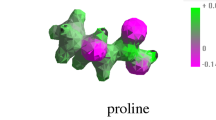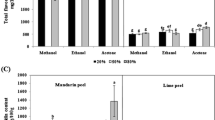Abstract
Conventional solvent extraction (CSE), microwave-assisted extraction (MAE) and ultrasound-assisted extraction (UAE) have used to recover phenolic substances from Okra stem (as a related agro-industrial waste). The influences of three extraction methods in terms of total phenolic content (TPC), antioxidant activities (AA) and extraction yield (EY) of Okra stem are investigated and compared. The DPPH, ABTS, FRAP, and β-carotene bleaching methods are used for determining AA. The phenolic compounds’ values existing in Okra stem are determined by High-performance liquid chromatography (HPLC) analysis. The optimized MAE has been compared with both optimized CSE and UAE. The results show that the former method gives the higher TPC (69.99 mg GAE g−1) in the shorter time as compared to CSE and UAE methods by about 89% and 78.17%, respectively. The UAE method shows the best performance in AA (53.06%, 60.10%, 0.94 mM TE g DE, and 69.27% for DPPH, ABTS, FRAP and β-carotene bleaching, respectively) and EY with the content of 19.24%. Regarding the phenolic profile, catechin derivative (9.45 mg g−1) is the main compound which is found in the extracts as well as hydroxycinnamic derivative (9.11 mg g−1) and flavonol (4.99 mg g−1). The obtained results indicate that Okra stems have the capability of being productive sources of phenolic compounds with antioxidant properties.






Similar content being viewed by others
References
Y. Chen, J.G. Zhang, H.J. Sun, Z.J. Wei, Pectin from Abelmoschus esculentus: optimization of extraction and rheological properties. Int. J. Biol. Macromol. 70, 498–505 (2014)
B. Yuan, C. Ritzoulis, J. Chen, Extensional and shear rheology of a food hydrocolloid. Food Hydrocoll. 74, 296–306 (2018). https://doi.org/10.1016/j.foodhyd.2017.08.019
Q. Yuan, S. Lin, Y. Fu, X.R. Nie, W. Liu, Y. Su, Q.H. Han, L. Zhao, Q. Zhang, D.R. Lin, W. Qin, D.T. Wu, Effects of extraction methods on the physicochemical characteristics and biological activities of polysaccharides from Okra (Abelmoschus esculentus). Int. J. Biol. Macromol. 127, 178–186 (2019). https://doi.org/10.1016/j.ijbiomac.2019.01.042
N. Jiang, C. Liu, D. Li, Z. Zhang, C. Liu, D. Wang, L. Niu, M. Zhang, Evaluation of freeze-drying combined with microwave vacuum drying for functional Okra snacks: Antioxidant properties, sensory quality, and energy consumption. LWT 82, 216–226 (2017). https://doi.org/10.1016/j.lwt.2017.04.015
N. Georgiadis, C. Ritzoulis, G. Sioura, P. Kornezou, C. Vasiliadou, C. Tsioptsias, Contribution of Okra extracts to the stability and rheology of oil-in-water emulsions. Food Hydrocoll. 25, 991–999 (2011). https://doi.org/10.1016/j.foodhyd.2010.09.014
V. Kontogiorgos, I. Margelou, N. Georgiadis, C. Ritzoulis, Rheological characterization of Okra pectins. Food Hydrocoll. 29(2), 356–362 (2012). https://doi.org/10.1016/j.foodhyd.2012.04.003
J. Liu, Y. Zhao, Q. Wu, A. John, Y. Jiang, J. Yang, H. Liu, B. Yang, Structure characterization of polysaccharides in vegetable “Okra” and evaluation of hypoglycemic activity. Food Chem. 242, 211–216 (2018). https://doi.org/10.1016/j.foodchem.2017.09.051
M.S. Jesus, Z. Genisheva, A. Romani, R.N. Pereira, J.A. Teixeira, L. Domingues, Bioactive compounds recovery optimization from vine pruning residues using conventional heating and microwave-assisted extraction methods. Ind. Crops Prod. 132, 99–110 (2019). https://doi.org/10.1016/j.indcrop.2019.01.070
M. Panic, M.R. Stojkovic, K. Kraljic, D. Skevin, I.R. Redovnikovic, V.G. Srcek, K. Radosevic, Ready-to-use green polyphenolic extracts from food by-products. Food Chem. 283, 628–636 (2019). https://doi.org/10.1016/j.foodchem.2019.01.061
P. Selvakumar, P. Sivashanmugam, Studies on the extraction of polyphenolic compounds from pre-consumer organic solid waste. J. Ind. Eng. Chem. 82, 130–137 (2020). https://doi.org/10.1016/j.jiec.2019.10.004
T.W. Caldas, K.E.L. Mazza, A.S.C. Teles, G.N. Mattos, A.I.S. Brigida, C.A. ConteJunior, R.G. Borguini, R.L.O. Godoy, L.M.C. Cabral, R.V. Tonon, Phenolic compounds recovery from grape skin using conventional and nonconventional extraction methods. Ind. Crops Prod. 111, 86–91 (2018). https://doi.org/10.1016/j.indcrop.2017.10.012
B. Ozturk, C. Parkinson, M. Gonzalez-Miquel, Extraction of polyphenolic antioxidants from orange peel waste using deep eutectic solvents. Sep. Purif. Technol. 206, 1–13 (2018). https://doi.org/10.1016/j.seppur.2018.05.052
X. Luo, J. Cui, H. Zhang, Y. Duan, D. Zhang, M. Cai, G. Chen, Ultrasound assisted extraction of polyphenolic compounds from red sorghum (Sorghum bicolor L.) bran and their biological activities and polyphenolic compositions. Ind. Crops Prod. 112, 296–304 (2018). https://doi.org/10.1016/j.indcrop.2017.12.019
G.S.D. Rosa, S.K. Vanga, Y. Gariepy, V. Raghavan, Comparison of microwave, ultrasonic and conventional techniques for extraction of bioactive compounds from olive leaves (Oleaeuropaea L.). Innovat. Food Sci. Emerg. Technol. 58, 102234 (2019). https://doi.org/10.1016/j.ifset.2019.102234
I. Zardo, A.D.E. Sobczyk, L.D.F. Marczak, J. Sarkis, Optimization of ultrasound-assisted extraction of phenolic compounds from sunflower seed cake using response surface methodology. Waste Biomass Valoriz. 10, 33–44 (2019). https://doi.org/10.1007/s12649-017-0038-3
F. Dahmoune, G. Spigno, K. Moussi, H. Remini, A. Cherbal, K. Madani, Pistacialentiscus leaves as a source of phenolic compounds: microwave-assisted extraction optimized and compared with ultrasound-assisted and conventional solvent extraction. Ind. Crops Prod. 61, 31–40 (2014). https://doi.org/10.1016/j.indcrop.2014.06.035
M. Hoda, S. Hemaiswarya, M. Doble, Role of Phenolic Phytochemicals in Diabetes Management: Phenolic Phytochemicals and Diabetes, 1st edn. (Springer, Singapore, 2019)
I. Ahmad, A. Yanuar, K. Mulia, A. Mun’im, Optimization of ionic liquid-based microwave-assisted extraction of polyphenolic content from Peperomia pellucida (L.) kunth using response surface methodology. Asian Pac. J. Trop. Biomed. 7(7), 660–665 (2017). https://doi.org/10.1016/j.apjtb.2017.06.010
G. Rocchetti, F. Blasi, D. Montesano, S. Ghisoni, M.C. Marcotullio, S. Sabatini, L. Cossignani, L. Lucini, Impact of conventional/non-conventional extraction methods on the untargeted phenolic profile of Moringa oleifera leaves. Food Res. Int. 115, 319–327 (2019). https://doi.org/10.1016/j.foodres.2018.11.046
M. Vinatoru, T.J. Mason, I. Calinescu, Ultrasonically assisted extraction (UAE) and microwave-assisted extraction (MAE) of functional compounds from plant materials. Trends Anal. Chem. 97, 159–178 (2017). https://doi.org/10.1016/j.trac.2017.09.002
S.-S. Teh, B.E. Niven, A.E.-D.A. Bekhit, A. Carne, E.J. Birch, Microwave and pulsed electric field assisted extractions of polyphenols from defatted canola seed cake. Int. J. Food Sci. Technol. 50(5), 1109–1115 (2015). https://doi.org/10.1111/ijfs.12749
I. Pawlaczyk-Graja, S. Balicki, K.A. Wilk, Effect of various extraction methods on the structure of polyphenolic-polysaccharide conjugates from Fragaria vesca L. leaf. Int. J. Biol. Macromol. 130, 664–674 (2019). https://doi.org/10.1016/j.ijbiomac.2019.03.013
K. Kaderides, L. Papaoikonomou, M. Serafim, A.M. Goula, Microwave-assisted extraction of phenolics from pomegranate peels: optimization, kinetics, and comparison with ultrasounds extraction. Chem. Eng. Process. 137, 1–11 (2019). https://doi.org/10.1016/j.cep.2019.01.006
L. Cassol, E. Rodrigues, C.P.Z. Norena, Extracting phenolic compounds from Hibiscussabdariffa L. calyx using microwave-assisted extraction. Ind. Crops Prod. 133, 168–177 (2019)
A.-M. Galan, I. Calinescu, A. Trifan, C. Winkworth-Smith, M. Calvo-Carrascal, C. Dodds, E. Binner, New insights into the role of selective and volumetric heating during microwave extraction: investigation of the extraction of polyphenolic compounds from sea buckthorn leaves using microwave-assisted extraction and conventional solvent extraction. Chem. Eng. Process. 116, 29–39 (2017). https://doi.org/10.1016/j.cep.2017.03.006
R.F. Dibanda, E.P. Akdowa, A. Rani, Q.M. Tongwa, C.M. Mbofung, Effect of microwave blanching on antioxidant activity, phenolic compounds and browning behavior of some fruit peelings. Food Chem. 302, 125308 (2020). https://doi.org/10.1016/j.foodchem.2019.125308
F. Chemat, G. Cravotto, Microwave-Assisted Extraction for Bioactive Compounds: Theory and Practice, 1st edn. (Springer, Boston, 2013)
M. Ramic, S. Vidovic, Z. Zekovic, J. Vladic, A. Cvejin, B. Pavlic, Modeling and optimization of ultrasound-assisted extraction of polyphenolic compounds from Aronia melanocarpa by-products from filter-tea factory. Ultrason. Sonochem. 23, 360–368 (2015). https://doi.org/10.1016/j.ultsonch.2014.10.002
L. Lingzhu, W. Lu, C. Dongyan, L. Jingbo, L. Songyi, Y. Haiqing, Y. Yuan, Optimization of ultrasound-assisted extraction of polyphenols from maize filaments by response surface methodology and its identification. J. Appl. Botany. Food Qual. 88, 152–163 (2015). https://doi.org/10.5073/JABFQ.2015.088.022
R.M. Bodoira, D.M. Maestri, Phenolic compounds from nuts: extraction, chemical profiles and bioactivity. J. Agric. Food Chem. 68(4), 927–942 (2020). https://doi.org/10.1021/acs.jafc.9b07160
N. El-Darra, N. Grimi, R.G. Maroun, N. Louka, E. Vorobiev, Pulsed electric field, ultrasound, and thermal pretreatments for better phenolic extraction during red fermentation. Eur. Food Res. Technol. 236, 47–56 (2013). https://doi.org/10.1007/s00217-012-1858-9
A. Ciric, B. Krajnc, D. Heath, N. Ogrinc, Response surface methodology and artificial neural network approach for the optimization of ultrasound-assisted extraction of polyphenols from garlic. Food. Chem. Toxicol. 135, 110976 (2020). https://doi.org/10.1016/j.fct.2019.110976
B.R. Albuquerque, M.A. Prieto, M.F. Barreiro, A. Rodrigues, T.P. Curran, L. Barros, I.C.F.R. Ferreira, Catechin-based extract optimization obtained from Arbutus unedo L. fruits using maceration/microwave/ultrasound extraction techniques. Ind. Crops Prod. 95, 404–415 (2017). https://doi.org/10.1016/j.indcrop.2016.10.050
I.M.D. Rosa, J.M. Kenny, M. Maniruzzaman, Md Moniruzzaman, M. Monti, D. Puglia, C. Santulli, F. Sarasini, Effect of chemical treatments on the mechanical and thermal behavior of Okra (Abelmoschus esculentus) fibers. Compos. Sci. Technol. 71(2), 246–254 (2011). https://doi.org/10.1016/j.compscitech.2010.11.023
E. Rincon, A.M. Balu, R. Luque, L. Serrano, Mechanochemical extraction of antioxidant phenolic compounds from Mediterranean and medicinal Laurus nobilis: a comparative study with other traditional and green novel techniques. Ind. Crops Prod. 141, 111805 (2019). https://doi.org/10.1016/j.indcrop.2019.111805
Q.D. Do, A.E. Angkawijaya, P.L. Tran-Nguyen, L.H. Huynh, F.E. Soetaredjo, S. Ismadji, Y.H. Ju, Effect of extraction solvent on total phenol content, total flavonoid content, and antioxidant activity of Limnophila aromatic. J. Food. Drug Anal. 22, 296–302 (2014). https://doi.org/10.1016/j.jfda.2013.11.001
P. Rodsamran, R. Sothornvit, Extraction of phenolic compounds from lime peel waste using ultrasonic-assisted and microwave-assisted extractions. Food Biosci. 28, 66–73 (2019). https://doi.org/10.1016/j.fbio.2019.01.017
F.T. Pastor, D.M. Šegan, S.Ž. Gorjanović, A.M. Kalušević, D.Ž. Sužnjević, Development of voltammetric methods for antioxidant activity determination based on Fe(III) reduction. Microchem. J. 155, 104721 (2020). https://doi.org/10.1016/j.microc.2020.104721
M. Hamed, H. Bougatef, W. Karoud, F. Krichen, A. Haddar, A. Bougatef, A. Sila, Polysaccharides extracted from pistachio external hull: characterization, antioxidant activity and potential application on meat as preservative. Ind. Crops Prod. 148, 112315 (2020). https://doi.org/10.1016/j.indcrop2020.112315
B. Pavlic, M. Kaplan, O. Bera, E.O. Olgun, O. Canli, N. Milosavljevic, B. Antic, Z. Zekovic, Microwave-assisted extraction of peppermint polyphenols: artificial neural networks approach. Food Bioprod. Process. 118, 258–269 (2019). https://doi.org/10.1016/j.fbp.2019.09.016
L.G.G. Rodrigues, S. Mazzutti, L. Vitali, G.A. Micke, S.R.S. Ferreira, Recovery of bioactive phenolic compounds from papaya seeds agro-industrial residue using subcritical water extraction. Biocatal. Agric. Biotechnol. 22, 101367 (2019)
P. Arapitsas, Identification and quantification of polyphenolic compounds from Okra seeds and skins. Food Chem. 110(4), 1041–1045 (2008). https://doi.org/10.1016/j.foodchem.2008.03.014
K. Biniari, M. Xenaki, I. Daskalakis, D. Rusjan, D. Bouza, M. Stavrakaki, Polyphenolic compounds and antioxidants of skin and berry grapes of Greek Vitis vinifera cultivars in relation to climate conditions. Food Chem. 307, 125518 (2020). https://doi.org/10.1016/j.foodchem.2019.125518
N. Medina-Torres, T. Ayora-Talavera, H. Espinosa-Andrews, A. Sanchez-Contreras, N. Pacheco, Ultrasound-Assisted Extraction for the Recovery of Phenolic Compounds from Vegetable Sources. Agronomy. 7(3), 47 (2017). https://doi.org/10.3390/agronomy7030047
S. Akbari, N.H. Abdurahman, R.M. Yunus, Optimization of saponins, phenolics, and antioxidants extracted from fenugreek seeds using microwave-assisted extraction and response surface methodology as an optimizing tool. Comptes Rendus Chim. 22(11–12), 714–727 (2019). https://doi.org/10.1016/j.crci.2019.07.007
O.R. Alara, S.K.A. Mudalip, N.H. Abdurahman, M.S. Mahmoud, E.O.O. Obanijesu, Data on parametric influence of microwave-assisted extraction on the recovery yield, total phenolic content and antioxidant activity of Phaleria macrocarpa fruit peel extract. Chem. Data Collect. 24, 100277 (2019). https://doi.org/10.1016/j.cdc.2019.100277
I. Drevelegka, A.M. Goula, Recovery of grape pomace phenolic compounds through optimized extraction and adsorption processes. Chem. Eng. Process. 149, 107845 (2020). https://doi.org/10.1016/j.cep.2020.107845
M.A. Bakht, M.H. Geesi, Y. Riadi, M. Imran, M.I. Ali, M.J. Ahsan, N. Ajmal, Ultrasound-assisted extraction of some branded tea: optimization based on polyphenol content, antioxidant potential and thermodynamic study. Saudi J. Biol. Sci. 26(5), 1043–1052 (2019). https://doi.org/10.1016/j.sjbs.2018.07.013
S. Ferarsa, W. Zhang, N. Moulai-Mostefa, L. Ding, M.Y. Jaffrin, N. Grimi, Recovery of anthocyanins and other phenolic compounds from purple eggplant peels and pulps using ultrasonic-assisted extraction. Food Bioprod. Processing. 109, 19–28 (2018). https://doi.org/10.1016/j.fbp.2018.02.006
K.V. Mahindrakar, V.K. Rathod, Ultrasonic assisted aqueous extraction of catechin and gallic acid from Syzygium cumini seed kernel and evaluation of total phenolic, flavonoid contents and antioxidant activity. Chem. Eng. Process. 149, 107841 (2020). https://doi.org/10.1016/j.cep.2020.107841
D. Pinto, E.F. Vieira, A.F. Peixoto, C. Freire, V. Freitas, P. Costa, C. Delerue-Matos, F. Rodrigues, Optimizing the extraction of phenolic antioxidants from chestnut shells by subcritical water extraction using response surface methodology. Food Chem. 334, 127521 (2021). https://doi.org/10.1016/j.foodchem.2020.127521
M. Grzesik, K. Naparło, G. Bartosz, I. Sadowska-Bartosz, Antioxidant properties of catechins: comparison with other antioxidants. Food Chem. 241, 480–492 (2018). https://doi.org/10.1016/j.foodchem.2017.08.117
Author information
Authors and Affiliations
Corresponding author
Ethics declarations
Conflict of interest
The authors have reported that no competing interests exist.
Additional information
Publisher's Note
Springer Nature remains neutral with regard to jurisdictional claims in published maps and institutional affiliations.
Rights and permissions
About this article
Cite this article
Amirabbasi, S., Elhamirad, A.H., Saeediasl, M.R. et al. Optimization of polyphenolic compounds extraction methods from Okra stem. Food Measure 15, 717–734 (2021). https://doi.org/10.1007/s11694-020-00641-8
Received:
Accepted:
Published:
Issue Date:
DOI: https://doi.org/10.1007/s11694-020-00641-8




